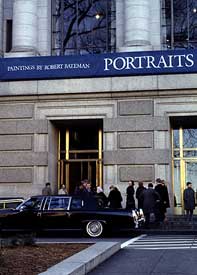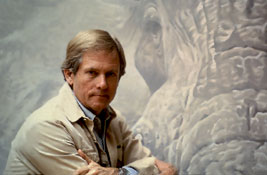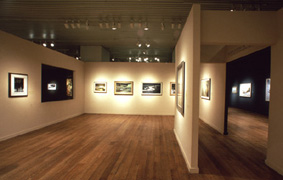|
Published
on the occasion of the exhibition |
|
|
Introduction
by Nature – the vast diversity and intricate interplay of life and environment on earth – is our indispensable common heritage, sheltering and sustaining all mankind. Through the ages, nature’s endless variety and riddles have challenged naturalists and philosophers; her inexhaustible images have inspired artists, poets, and writers. As observers of nature, the artist and the naturalist have always been natural allies. But each has explored the reaches of nature from a unique perspective, portraying nature’s reality in different but complementary form.
Today’s naturalist is a highly specialized scientist, a systematic biologist or systematist, who studies biological diversity with the latest technology. The basic task is far from finished – discovering, describing, and classifying the millions of species (perhaps thirty million) in the world. But the present-day systematist is far more than an explorer and cataloger; he is also a biologist who tries to explain both the evolutionary and the ecological place of species in nature. Despite his high-tech tools, the modern naturalist still must rely fundamentally on his powers of observation, description and inference to perceive and portray nature’s reality. In time-honoured scientific tradition, he paints his perceptions with woods and his canvas is the printed page. But the naturalist’s language is often so arcane that his portraits of nature assume little real form save in the minds of kindred scientists. The artist, by contrast, has always perceived natural diversity through another eye of the mind and painted his perceptions of nature in the universal language of color. His images, often stylized or idealized, may be meticulously realistic or may symbolize or distill some larger essence of the natural realm. Such distillations can take on abstract or impressionistic form, or the realism of a photographic portrait.
Only realist art can illuminate and authenticate the naturalist’s word pictures of the rich diversity in nature. And skillful scientific illustration, a specialized form of art realism, has long been the indispensable servant of scientific description. With the rise of modern photography, however, the painter’s brush has frequently taken second place to the photographer’s lens in the portrayal of the natural world. This is lamentable in many instances because the eye of the artist often sees nature’s reality quite differently from the eye of the camera. The camera, for instance, freezes but a moment in time and space. Its image is slavishly faithful to its subject, with focus fixed by the inflexible laws of optics, often giving us shallow foreground without background or background without foreground. The artist, however, can telescope time and space with the conceptualizing lens of the mind; he can synthesize, synchronize, and idealize nature’s images. The artist can compose the essence of reality into synthetic visual wholes, creating a differential or complete depth of focus that deliberately sharpens the essential, relevant and pleasing elements while obscuring or eliminating harsh and irrelevant distractions. Paintings of nature can also be far more effective than the photographer’s pictures in depicting the often subtle features that distinguish one species of animal or plant from another, or in portraying a species in its habitat or larger ecological setting. Perhaps most important of all, the gifted nature artist can transform a panoramic landscape or a doorstep vignette into a true portrait of nature with power and feeling, a grand ecological synthesis that is at once an authoritative statement of relationship and unity and an evocative message of priceless heritage and higher human values. In this sense, the portrait becomes a call to observation, compelling concern for the environmental welfare of continents and oceans and spurring action to preserve wilderness near and far. Robert Bateman is at once naturalist, artist, teacher, and conservationist. His camera-defying brush captures the reality of nature with uncanny authenticity. He is a realist painter because he knows through his own personal odyssey the limitations of abstract and impressionist art for the artist who wishes to portray what Bateman calls the “particularity of nature”. Nature’s diversity rarely assumes specific identity merely through impressions or abstractions; this diversity resolves itself into recognizable species and habitats only through the proper comprehension and use of detail. When Bateman paints a species of bird or mammal, it must be sufficiently detailed to be identifiable, without being so feather- or fur-perfect that it stands apart from its setting as a field-guide cameo. In his often elaborate settings, he uses just enough detail to impart a sense of both scientific authenticity and photographic fidelity. The background may remain deliberately generic, sketched in only so far as it authenticates the main focus of the painting. Nature is a matter of focus and scale. On the grandest scale is the planet Earth – a global landscape. When, as through some cosmic zoom lens, the naturalist or the artist focuses on the earth’s natural realm with increasing powers of magnification, the global landscape assumes ecological fabric and texture in ever greater detail, resolving itself into naturescapes and habitats at all levels from oceans and continents to life-zones, biomes, communities, and, ultimately, to the fine structure of nature – individual species and local environments. On every scale – structure and pattern. On every level – scientific intrigue and artistic beauty.
At one time or another, Robert Bateman has assumed each of these viewpoints and his paintings reflect the full gamut of perspectives and perceptions. As an artist he is able to convey a vivid comprehension of diversity because, as naturalist, he has mastered the particularity of nature. ~ |
 Naturalists
have spent centuries cataloguing and explaining the enormous diversity
of plants and animals in nature. The great natural history museums of
the world, such as the Smithsonian’s National Museum of Natural History,
are storehouses for the naturalists’ immense collections, providing
essential documentation of their discoveries. These museums keep the
catalog of nature and the knowledge we have acquired about the earth’s
biological diversity. Naturalists are the keepers of the keys to this
catalog and this knowledge.
Naturalists
have spent centuries cataloguing and explaining the enormous diversity
of plants and animals in nature. The great natural history museums of
the world, such as the Smithsonian’s National Museum of Natural History,
are storehouses for the naturalists’ immense collections, providing
essential documentation of their discoveries. These museums keep the
catalog of nature and the knowledge we have acquired about the earth’s
biological diversity. Naturalists are the keepers of the keys to this
catalog and this knowledge. 
 Nature
is also a matter of perspective and perception. From one vantage point,
the naturalist or the artist may survey the ecological landscape and
see individual species, habitats, or interactions, while from another
viewpoint nature appears only as integrated communities or ecosystems
of closely inter-related organisms and environments. Still another may
be fascinated by process, by the rhythms and cycles of nature. Some
dwell on the continuities and revel in the familiar or the commonplace.
Others are absorbed in the rich diversity of life and are magnetically
drawn to wilderness and to exotic biotas. Some become so sensitized
to the rare and the unusual within the vast matrix of habitats and living
forms that they deliberately look beyond nature’s hoi polloi to
focus on the vanishing jewels. These precious remnants, all too rapidly
slipping over the brink into extinction, are perceived as the epitome
of the natural realm, the very essence of what is worth keeping.
Nature
is also a matter of perspective and perception. From one vantage point,
the naturalist or the artist may survey the ecological landscape and
see individual species, habitats, or interactions, while from another
viewpoint nature appears only as integrated communities or ecosystems
of closely inter-related organisms and environments. Still another may
be fascinated by process, by the rhythms and cycles of nature. Some
dwell on the continuities and revel in the familiar or the commonplace.
Others are absorbed in the rich diversity of life and are magnetically
drawn to wilderness and to exotic biotas. Some become so sensitized
to the rare and the unusual within the vast matrix of habitats and living
forms that they deliberately look beyond nature’s hoi polloi to
focus on the vanishing jewels. These precious remnants, all too rapidly
slipping over the brink into extinction, are perceived as the epitome
of the natural realm, the very essence of what is worth keeping.